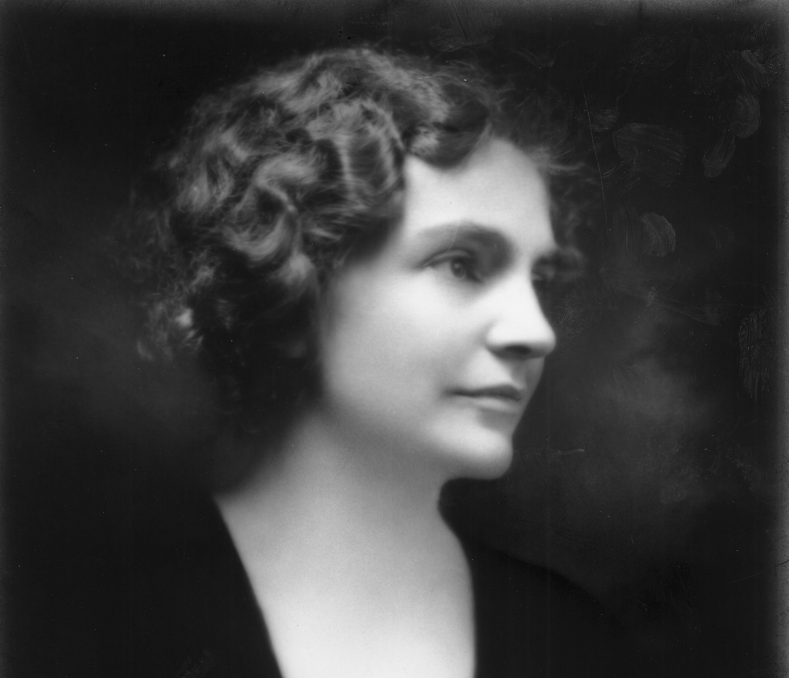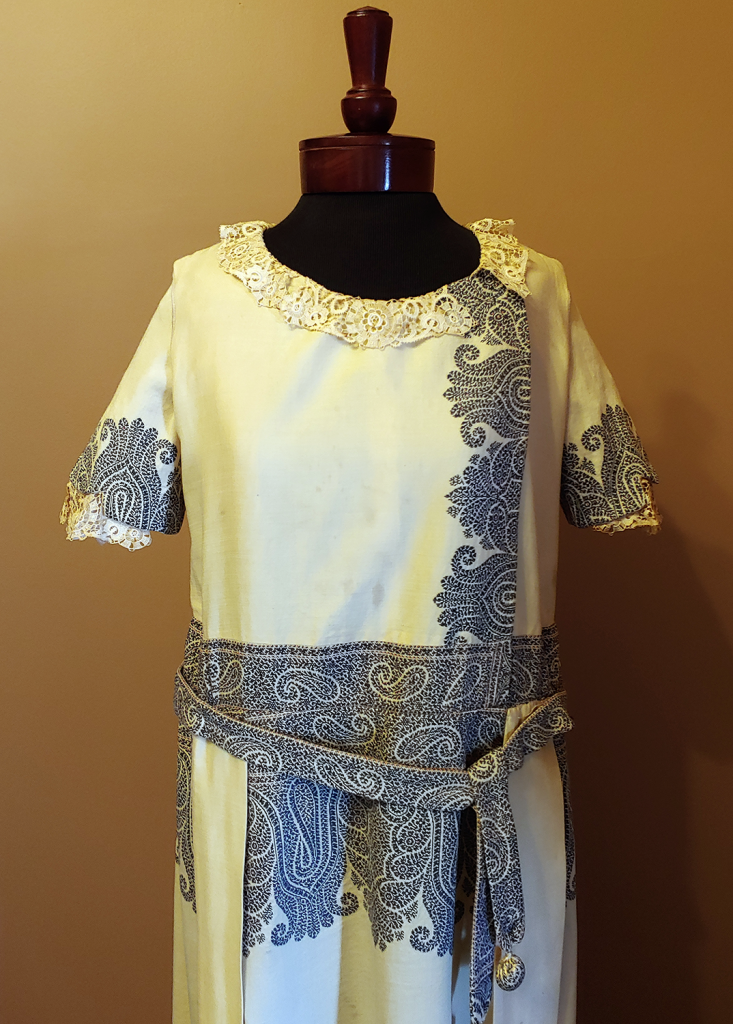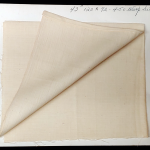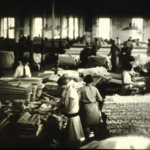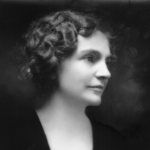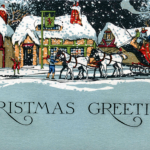Last Friday there was a delivery.
The three medium-sized boxes contained material that had once belonged to Florence Cook Brigham – my dearest friend and mentor – and that after her death passed to her son, and then to his widow, who in turn donated them to the FRHS.
As promised, there was an odd assortment of clothing dating to the late-nineteenth and early-twentieth century, a selection of photographs and ephemera, and several books, mostly presentation copies gifted and inscribed to Mrs. B. by some of the many authors who she assisted over the years. Mrs. B. would have said they were coming home.
I was looking forward to opening the boxes, eager to see what they contained, but at the same time I hesitated – they had been Mrs. B’s things and, for whatever reason, the time was not right – so there they sat for a few days, until I felt it was.
Yesterday, I opened the boxes.
For me, opening them and sorting through the contents was something of a revelation – some things were unfamiliar to me, but others, very much the opposite. Recollections of stories I had been told flooded back and flashed repeatedly, like the incessant light of a bevy of paparazzi.
Among the clothing was an elaborate royal purple velvet dress, heavily laden with passementerie, trimmings, and re-embroidered lace – it was the work of an exclusive London couturier and, I remembered, had been worn by “Aunt Anne” circa 1900.
Annie Sheen, a Fall River native, was the sister of Mrs. B’s mother-in-law; she married her childhood sweetheart, William Lindsey, called “Uncle Will” by their Brigham nephew, who became Mrs. B’s husband. As the nineteenth century morphed into the early twentieth, the industrious Uncle Will made a fortune manufacturing a light-weight military cartridge belt that became standard issue throughout the British Empire and in the vast majority of countries across Europe – he made millions, astonishingly fast, and retired from active business after only a few years. Needless to say, Aunt Anne – she quickly styled herself Anne Hawthorn Lindsey – was delighted.
Why the name change?
“Annie Sheen sounds too much like a kitchen maid,” she said.
Aunt Anne lived extremely well, travelled in exalted social circles in America and abroad, dressed and played the part, and was something of a bon vivant. A pinnacle in her career as a grand dame: She was presented at the Court of St. James to King George V and Queen Mary in 1932.
A far cry from Fall River, that.
The Lindsey family – there were three children, one of whom had tragically lost her life in the sinking of the Lusitania while on her wedding trip – resided at one point or another in very grand residences in Boston, London, and the South of France. And there was a rambling summer home, Hawthorne House, on Cape Cod.
As “Uncle Will” once said: “I have made a lot of money in my life, and I married the right girl to help me spend it.”
I knew the dress and its history, because Mrs. B. had worn it in the 1980s during a historic house tour held by the Preservation Society in which the FRHS took part; people were encouraged to wear period clothing and someone – it certainly was not me – encouraged Mrs. B. to participate. The dress was too big for her, it was held on with safety pins, and Mrs. B. said she “looked and felt like the old Harry.” I wore a West Point cadet uniform, circa 1900.
It brought a smile to my face, seeing that dress.
Note to self:
Find the photograph of Mrs. B. wearing it.
But one discovery immediately triggered a vivid memory, a recollection that rapidly set off a playback – as clear as if it had just been recorded – and I could hear Mrs. B’s voice in my mind:
“Imagine, Michael … her own grandmother’s paisley shawl.”
I did not think it had survived.
Unzipping the semi-opaque garment bag through which I thought I noticed a cloudy glimpse of paisley, I was rewarded with an answer in the affirmative.
Indeed, it had survived.
I had heard many stories about that paisley.
Flashback: Fall River, Massachusetts, early 1922.
Florence Cook – recently engaged to Richard Curtis Brigham, called “Dick” – was searching for a dressmaker to design and execute her wedding gown and a portion of her trousseau. Who to choose? Some wealthy friends went abroad, to Paris – not an option – others used various Boston houses, and the Tirocchi sisters in Providence were a safe, albeit costly, choice. Many Fall River women used the Tirocchi sisters, and Florence knew their work.
But it would be far more economical to have the work done in Fall River, and the soon-to-be bride was practical. By her own admission, a fashionista, she was not: “I was never really interested in clothes much, unlike many of my friends,” she often said.
Of course, in this case, her wedding gown had to be perfect: Dick’s Aunt Anne had gifted her soon-to-be-niece-by-marriage a length of silk satin from Liberty’s, in London, as well as the lace – handmade and very fine – from some European shop she frequented.
When her engagement was announced, Mrs. B. had been “summoned to Boston to spend a weekend with Aunt Anne” at her Tudor-Revival mansion at 225 Bay State Road. She was careful to be on her “best behavior” because, as she put it, “I was being looked over.” Was she a suitable bride for the boy Aunt Anne doted on and called “Dickie”?
Not to worry: The visit was a success, evidenced by the gift of expensive fabric and valuable lace.
Someone – if Mrs. B. ever said who it was, I do not recollect – told Mrs. B’s mother about Madame Thuot in Fall River, a modiste who maintained workrooms in her home on Ridge Street; her work was exemplary, her mode au courant, and she came highly recommended.
And so, Mrs. and Miss Cook made an appointment and liked what they saw; a dress was commissioned – “to try her out” – with Madame Thuot having full charge of the design.
The choice of fabric:
Much to Mrs. B’s astonishment, her mother insisted that the dress be cut from her grandmother’s – Mrs. B’s great-grandmother’s – cashmere wool shawl, a fine example with a cream field, bordered in a slate blue paisley, heightened in rose. It was a family heirloom, dating from the middle of the nineteenth century.
“Imagine, Michael, she gave me her own grandmother’s paisley shawl,” she said. “Mother treasured that shawl.”
Mrs. B. was clearly very touched: She kept the dress for the remainder of her very long life.
In my estimation “Mother” was also very wise:
To fashion and cut a dress from a paisley shawl required great skill in design and execution; with a limited amount of fabric to work with there was no room for error; and to fully maximize the effect of the bold design – it could easily appear inconsistent or patchy – mandated adept technical expertise and a keen sense of style.
It was, I think, something of a test.
Madame Thout made the most of what she had to work with – excess yardage there was not. Yet she created a fashionable, and versatile, two-piece dress that was suitable for day wear, when worn with undersleeves, or for evening wear, when worn without. The finished garment was trimmed in tatted lace at the neckline and sleeves.
The Cook women were pleased: Mrs. B. wore the dress, and Madame Thuot was commissioned for a wedding gown and trousseau.
And for several years thereafter, Mrs. B. continued to use Madame Thuot.
A funny story:
In about 1930, Mrs. B. paid a call to the dressmaker, accompanied by her very young son, “Dick Jr.” On entering the house, the boy noticed a peculiar, unfamiliar odor: “Mummy, what stinks?” said the boy in a clear voice, just as Madame Thuot was opening the door. “She must have heard him,” Mrs. Brigham said, always laughing when relaying the story.
“They must have been cooking something, and stink, it did.”
The dress, by the way, has survived in a fair state of preservation; there is a light scattering of insect holes, as one would expect in wool, and a few small areas of staining, evidence of some long-forgotten meal or beverage. Treatment by a textile conservator will stabilize the fabric and reduce the staining; perhaps, someday, we can raise the funds to undertake the work.
It certainly is warranted.
And so now, nearly one hundred years after it was made for Mrs. B., the dress cut from an heirloom paisley shawl joins her wedding ensemble in the collection of the FRHS.
She would be pleased – very much so.
As am I.
I may be mistaken, but I suppose there is no one else left who knows the story of the dress cut from a heirloom paisley shawl – at least now it can be documented. If nothing else, it is nice to think that something from the font of useless knowledge about the history of other people’s families that has accumulated in my brain has been useful.
And what of the dressmaker?
Helene Thuot, née Cote (1886-1976), was born in Trois Pistoles, Quebec, Canada, the daughter of Simon and Philomene (Lavoie) Cote; she was residing in Fall River by 1896. In 1910, she married Hormisdas Levi Thuot (1879-1917), a photographer, in a ceremony at St. Anne’s Church. She is first listed in the Fall River Directory in 1911 as a dressmaker, an occupation in which she remained – successfully – until retiring in about 1956. Among her clientele were the wives and daughters of Fall River’s leading French-Canadian, and Yankee, families.
Research into the life and career of this talented Fall River dressmaker is ongoing.
And now back to the boxes.
There were also a few mementos of me that had been saved by Mrs. B. – either intentionally or by chance – newspaper clippings, snapshots, and a few letters. I freely admit they brought back a flood of memories and a surprising welling of emotion, this from a person who, as I have often stated, has never been particularly prone to sentiment.
It came to the fore, I suppose, via thoughts of my greatest friend and mentor – gone now these twenty years – and prompted by recollections as I glanced at the images, and read the words, and remembered days past.
For over two decades she directed the path of my life and is fondly seared into my being; she was a dear friend, sincere and unfaltering.
I owe her much.
It was a debt Mrs. B would never acknowledge and, therefore, never claim.
Sentiment, I have been told, often emerges as one ages; older, I am getting.
Monday is Memorial Day …

